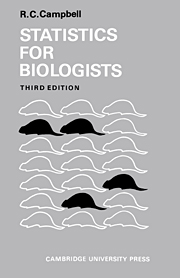Book contents
- Frontmatter
- Contents
- PREFACE
- PREFACE TO SECOND EDITION
- PREFACE TO THIRD EDITION
- 1 WHAT IS STATISTICS ABOUT?
- 2 PRESENTING THE INFORMATION CONTAINED IN ONE SAMPLE
- 3 COMPARING SEVERAL SAMPLES
- 4 ASSOCIATION
- 5 CHOOSING BETWEEN ACTIONS
- 6 THE NORMAL DISTRIBUTION
- 7 THE NORMAL VARIABLE IN EXPERIMENTS AND SURVEYS
- 8 ASSOCIATED NORMAL VARIABLES
- 9 SOME NON-NORMAL DISTRIBUTIONS
- FURTHER READING
- REFERENCES
- APPENDIX: TABLES AND FIGURES FOR STATISTICAL TESTS AND EXERCISES
- INDEX
3 - COMPARING SEVERAL SAMPLES
Published online by Cambridge University Press: 05 June 2012
- Frontmatter
- Contents
- PREFACE
- PREFACE TO SECOND EDITION
- PREFACE TO THIRD EDITION
- 1 WHAT IS STATISTICS ABOUT?
- 2 PRESENTING THE INFORMATION CONTAINED IN ONE SAMPLE
- 3 COMPARING SEVERAL SAMPLES
- 4 ASSOCIATION
- 5 CHOOSING BETWEEN ACTIONS
- 6 THE NORMAL DISTRIBUTION
- 7 THE NORMAL VARIABLE IN EXPERIMENTS AND SURVEYS
- 8 ASSOCIATED NORMAL VARIABLES
- 9 SOME NON-NORMAL DISTRIBUTIONS
- FURTHER READING
- REFERENCES
- APPENDIX: TABLES AND FIGURES FOR STATISTICAL TESTS AND EXERCISES
- INDEX
Summary
The problem
The methods described in chapter 2 enable us to summarize some of the information contained in one sample. Further kinds of summary for use in this case will be given later, but we turn first to consider how the methods already set out need to be modified and extended when we have several samples and wish to investigate the possibility that they come from different populations. We remind ourselves that all the questions that really matter will concern the populations; it is of no interest to know whether the samples differ because, whether they do or not, the next samples we take will almost certainly do so even if the populations are identical. The fact of random variation means, as before, that we are interested in the samples only for what they tell about the populations.
Pictorial presentation
The first kind of summary that we used for one sample was a histogram. When we have several samples we can draw a histogram for each, as we did for subsamples in 2.1.1.2. Similarly if we have multiple measurements we can, in the manner of 2.4.1, draw a pie diagram or a bar chart for each sample. We shall usually find however that, although these methods are useful first summaries, they do not enable us to see very clearly the differences between the samples; in particular they give no indication whether these differences are reflections of genuine population differences or whether they can be regarded simply as artefacts produced by random variation.
- Type
- Chapter
- Information
- Statistics for Biologists , pp. 61 - 106Publisher: Cambridge University PressPrint publication year: 1989
- 1
- Cited by



